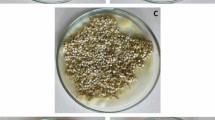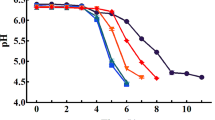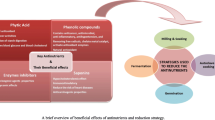Abstract
In this study, quinoa seeds were processed to flour in ungerminated (raw) and germinated forms. Raw quinoa flour (RQF) and germinated quinoa flour (GQF) were replaced (0, 10, 20 and 30%) with wheat semolina in pasta formulation to improve nutritional and functional properties of pasta. Some chemical (ash, crude fat, crude protein, total phenolic content (TPC), antioxidant activity (AA) and mineral matter), anti-nutritional (phytic acid), physical and sensory properties of pasta samples were determined. With germination of quinoa seed, ash, protein, TPC and AA amount of GQF increased by 51%, 37%, 111%, 123% and 17%, respectively, while phytic acid amount decreased by 77%, in comparison to RQF. As the RQF or GQF ratio increased in pasta formulation, ash, crude protein, TPC, AA and mineral matter amounts significantly (p < 0.05) increased. Such parameters linearly increased with the elevated ratio of quinoa flour. Compared to RQF, GQF at high utilization ratios displayed higher negative effects on cooking quality of pasta, but it showed great performance on increasing nutritional and functional properties.


Similar content being viewed by others
References
AACC (1990) Approved methods of the American Association of cereal chemists, 8th edn. AACC, St. Paul
Beta T, Nam S, Dexter JE, Sapirstein HD (2005) Phenolic content and antioxidant activity of pearled wheat and roller-milled fractions. Cereal Chem 82:390–393
Brennan CS, Tudorica CM (2008) Evaluation of potential mechanisms by which dietary fibre additions reduce the predicted glycemic index of fresh pastas. Int J Food Sci Technol 43:2151–2162
Cornejo F, Caceres PJ, Martínez-Villaluenga C, Rosell CM, Frias J (2015) Effects of germination on the nutritive value and bioactive compounds of brown rice breads. Food Chem 173:298–304
Coulibaly A, Chen J (2011) Evolution of energetic compounds, antioxidant capacity, some vitamins and minerals, phytase and amylase activity during the germination of foxtail millet. Am J Food Technol 6:40–51
Diaz-Batalla L, Widholm JM, Fahey GC, Castaño-Tostado E, Paredes-López O (2006) Chemical components with health implications in wild and cultivated Mexican common bean seeds (Phaseolus vulgaris L.). J Agric Food Chem 54:2045–2052
Düzgüneş O, Kesici T, Kavuncu O, Gürbüz F (1987) Araştırma ve Deneme Metodları (İstatistiksel Metodları-II), Ankara Ünivirsitesi, Ziraat Fakültesi publication number: 1021, Ankara, p 381
Epler S, Chambers E, Kemp KE (1998) Hedonic scales are a better predictor than just-about-right scales of optimal sweetness in lemonade. J Sens Stud 13:191–197
Fazaeli H, Golmohammadi HA, Tabatabayee SN, Asghari-Tabrizi M (2012) Productivity and nutritive value of barley green fodder yield in hydroponic system. World Appl Sci J 16:531–539
Fiorda FA, Soares MS Jr, Da Silva FA, Grosmann MV, Souto LR (2013) Microestructure, texture and colour of gluten-free pasta made with amaranth flour, cassava starch and cassava bagasse. LWT-Food Sci Technol 54:132–138
Gamez-Meza N, Noriega-Rodriguez JA, Medina-Juarez LA, Ortega Garcia J, Cazarez-Casanova R, Angulo-Guerrero O (1999) Antioxidant activity in soybean oil of extracts from Thompson grape bagasse. J Am Oil Chem Soc 76:1445–1447
Grant LA, Dick JW, Shelton DR (1993) Effect of drying temperature, starch damage sprouting and additives on spaghetti quality characteristics. Cereal Chem 70:676–684
Gyamfi MA, Yonamine M, Aniya Y (1999) Free radical scavenging action of medical herbs from Ghana: Thonningia sanguinea on experimentally-induced liver injuries. Gen Pharmacol 32:661–667
Ha DH, Park YK (2011) Quality characteristics of noodles added with domestic germinated barley. Korean J Food Preserv 18:131–142
Haug W, Lantzsch HJ (1983) Sensitive method for the rapid determination of phytate in cereals and cereal products. J Sci Food Agric 34:1423–1426
Herken (2005) Effect of processing on the selected properties of cowpea flour to be incorporated into spaghetti. Phd thesis. University of Gaziantep, Gaziantep, Turkey. Available from: https://tez.yok.gov.tr/UlusalTezMerkezi/tezSorguSonucYeni.jsp
Ibrahim SS, Habiba RA, Shatta AA, Embaby HE (2002) Effect of soaking, germination, cooking and fermentation on antinutritional factors in cowpeas. Nahrung 46:92–95
Izydorczyk MS, Lagasse SL, Hatcher DW, Dexter JE, Rossnagel BG (2005) The enrichment of Asian noodles with fiber-rich fractions derived from roller milling of hull-less barley. J Sci Food Agric 85:2094–2104
Koziol MJ (1992) Chemical composition and nutritional evaluation of quinoa (Chenopodium quinoa Willd.). J Food Compos Anal 5:35–68
Liu T, Hou GG, Cardin M, Marquart L, Dubat A (2017) Quality attributes of whole-wheat flour tortillas with sprouted whole-wheat flour substitution. LWT-Food Sci Technol 77:1–7
Lorusso A, Verni M, Montemurro M, Coda R, Gobbetti M, Rizzello CG (2017) Use of fermented quinoa flour for pasta making and evaluation of the technological and nutritional features. LWT-Food Sci Technol 78:215–221
Morgan JV, Hunter RR (1993) Limiting factors in hydroponic barley grass production. In: Poster session presentation at the meeting of the Proceedings of the 8th International Congress on Soilless Culture, Hunter's Rest, South Africa.
Oatway L, Vasanthan T, Helm JH (2001) Phytic acid Food Rev Int 17(4):419–431
Oh NH, Seib PA, Chung DS (1985) Noodle III. Effects of processing variables on the quality of dry noodle. Cereal Chem 62:437–440
Özkaya H, Kahveci B (1990) The analysis methods of cereal and crops. The Journal of Food Technology Association, Ankara, Turkey (in Turkish)
Paśko P, Bartoń H, Zagrodzki P, Gorinstein S, Fołta M, Zachwieja Z (2009) Anthocyanins, total polyphenols and antioxidant activity in amaranth and quinoa seeds and sprouts during their growt. Food Chem 115:994–998
Pınarlı İ, İbanoğlu Ş, Öner MD (2002) Ham ve mikrodalgada kavrulmuş ruşeymle üretilen makarna üzerine araştırmalar. In: Paper presented at the cereal products technology congress and exhibition, Gaziantep, Turkey, pp 645–654 (in Turkish)
Prinyawiwatkul W, Beuchat LR, McWatters KH (1993) Functional property changes in partially defatted peanut flour caused by fungal fermentation and heat treatment. J Food Sci 58:1318–1323
Repo-Carrasco-Valencia R, Hellstrom JK, Pihlava JM, Mattila PH (2010) Flavonoids and other phenolic compounds in Andean indigenous grains: Quinoa (Chenopodium quinoa), kañiwa (Chenopodium pallidicaule) and kiwicha (Amaranthus caudatus). Food Chem 120:128–133
Skujins S (1998) Handbook for ICP-AES (Vartian-Vista). In: A short guide to vista series ICP-AES operation. Variant Int. AG, Zug, version 1.0, Switzerland
Seol H, Sim KH (2017) Quality characteristics of noodles with added germinated black quinoa powder. Korean J Food and Nutr 30:19–30
Slinkard K, Singelton VL (1977) Total phenolic analysis, automation and comparison with manual methods. Am J Enol Vitic 28:49–55
Sözer N, Kaya A (2002) Spagettinin Dokusal ve Pişme Özellikleri. In: Paper presented at the cereal products technology congress and exhibition, Gaziantep, Turkey, pp 339–351 (in Turkish)
Torres A, Frias J, Granito M, Vidal-Valverde C (2007) Germinated Cajanus cajan seeds as ingredients in pastaproducts: chemical, biological and sensory evaluation. Food Chem 101:202–211
Vayupharp B, Laksanalamai V (2013) Nutrients and anti-nutrients of high chlorophyll-mungbean sprouts as affected by different periods of germination and sprouting stages. Agric Biol Eng 6:121–129
Yeyinli N (2006) The Use of textural methods in determining the quality of pasta. Master thesis. University of Celal Bayar, Manisa, Turkey. Available from: https://tez.yok.gov.tr/UlusalTezMerkezi/tezSorguSonucYeni.jsp
Acknowledgements
This research was summarized from Ph.D. thesis (Necmettin Erbakan University the Graduate School of Natural and Applied Science Department in Food Engineering) by Berat Demir. This study was supported by the Scientific Research Project Unit of Necmettin Erbakan University, Konya, Turkey (Project Number, BAP-161419002).
Author information
Authors and Affiliations
Corresponding author
Ethics declarations
Conflict of interest
Authors declare no conflict of interest.
Additional information
Publisher's Note
Springer Nature remains neutral with regard to jurisdictional claims in published maps and institutional affiliations.
Rights and permissions
About this article
Cite this article
Demir, B., Bilgiçli, N. Changes in chemical and anti-nutritional properties of pasta enriched with raw and germinated quinoa (Chenopodium quinoa Willd.) flours. J Food Sci Technol 57, 3884–3892 (2020). https://doi.org/10.1007/s13197-020-04420-7
Revised:
Accepted:
Published:
Issue Date:
DOI: https://doi.org/10.1007/s13197-020-04420-7




